Lodi, Lombardy
Lodi (/ˈloʊdi/ LOH-dee, Italian: [ˈlɔːdi] ⓘ; Ludesan: Lòd) is a city and comune in Lombardy, northern Italy, primarily on the western bank of the River Adda. It is the capital of the province of Lodi.
Lodi
| |
|---|---|
| Comune di Lodi | |
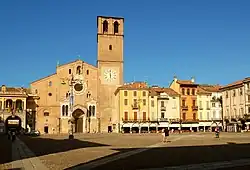 Piazza della Vittoria | |
 Flag  Coat of arms | |
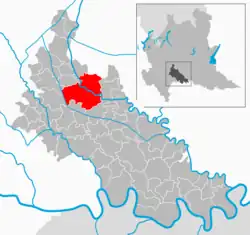 | |
Location of Lodi | |
 Lodi Location of Lodi in Italy  Lodi Lodi (Lombardy) | |
| Coordinates: 45°19′N 9°30′E | |
| Country | Italy |
| Region | Lombardy |
| Province | Lodi (LO) |
| Frazioni | Fontana, Olmo, Riolo, San Grato |
| Government | |
| • Mayor | Andrea Furegato[1] (Democratic Party) |
| Area | |
| • Total | 41 km2 (16 sq mi) |
| Elevation | 87 m (285 ft) |
| Population (1 January 2017)[3] | |
| • Total | 45,212 |
| • Density | 1,100/km2 (2,900/sq mi) |
| Demonym | Lodigiani or Laudensi |
| Time zone | UTC+1 (CET) |
| • Summer (DST) | UTC+2 (CEST) |
| Postal code | 26900 |
| Dialing code | 0371 |
| Patron saint | St. Bassianus |
| Saint day | 19 January |
| Website | Official website |
History
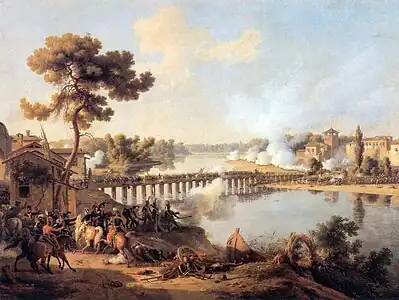
Lodi was a Celtic village; in Roman times it was called, in Latin, Laus Pompeia (probably in honour of the consul Gnaeus Pompeius Strabo) and was known also because its position allowed many Gauls of Gallia Cisalpina to obtain Roman citizenship. It was in an important position where a vital Roman road crossed the River Adda.
Lodi became the see of a diocese in the 3rd century. Saint Bassianus (San Bassiano) is the patron saint of the town.
A free commune around 1000, it fiercely resisted the Milanese, who destroyed it in 1111. The old town corresponds to the modern Lodi Vecchio. Frederick Barbarossa rebuilt it on its current location in 1158.
From 1220, the Lodigiani (inhabitants of Lodi) spent decades in constructing a system of miles of artificial rivers and channels (called Consorzio di Muzza). It was created to give water to the countryside, turning arid areas into one of the region's important agricultural areas.
From the 14th century Lodi was ruled by the Visconti family, who built a castle there. In 1413, the antipope John XXIII launched the bull by which he convened the Council of Constance from the Duomo of Lodi. The council marked the end of the Great Schism.
In 1454, representatives from all the regional states of Italy met in Lodi to sign the treaty known as the peace of Lodi, by which they intended to pursue Italian unification. This peace lasted 40 years.
The town was then ruled by the Sforza family, France, Spain and Austria. In 1786 it became the eponymous capital of a province that between 1815 and 1859 would have included Crema.
On 10 May 1796, in the first major battle of his career as a general, the young Napoleon Bonaparte defeated the Austrians aka the 1526-1804 Habsburg monarchy in the Battle of Lodi. In the second half of the 19th century, Lodi began to expand outside the city walls, boosted by economic expansion and the construction of railway lines that followed the unification of Italy.
In 1945, the Italian petrol company Agip, directed by Enrico Mattei, started extracting methane from its fields, and Lodi was the first Italian town with a regular domestic gas service. Today the town is at the heart of important communication routes, and is a technologically advanced industrial centre, maintaining, however, also its strong traditional ceramics tradition.
Main sights

- Piazza della Vittoria, listed by the Italian Touring Club among the most beautiful squares in Italy.[4] Featuring porticoes on all its four sides, it includes the Basilica della Vergine Assunta and the Broletto (town hall).
- Piazza Broletto, with a Verona marble baptismal font dating to the 14th century.
- Beata Vergine Incoronata, church in style of Lombard Renaissance.
- San Francesco, a Gothic-style church built in 1280–1307.
- San Lorenzo, a church with frescoes by Callisto Piazza.
- Santa Maria del Sole, a late Baroque-style Catholic church.
- Santa Maria Maddalena, a Baroque church. The original Romanesque structure (1162) was replaced in the 18th century. The interior has frescoes by Carlo Innocenzo Carloni and a Deposition attributed to Robert de Longe.
- Sant'Agnese, church in Lombard Gothic style (14th century). It includes the Galliani Polyptych by Albertino Piazza (1520), and has, on the façade, a rose window decorated with polychrome majolica.
- San Filippo, Rococo-style church
- Palazzo Vescovile (Bishopric Palace), of medieval origin but rebuilt in the 18th century.
- San Cristoforo, church designed by Pellegrino Tibaldi.
- Visconti Castle (Torrione), a medieval castle now partially destroyed.
- Palazzo Mozzanica (15th century)
- Palazzo Modignani, 18th-century urban palace
- Torre di Lodi, a modern building high 70 meters about. It is located in the Business District, and it is the tallest building in the city.
- Biblioteca Laudense located in Palazzo San Filippo, adjacent to church
Government
Economy
In 1864 Tiziano Zalli founded the Banca Popolare di Lodi, the first Italian cooperative bank (now part of Banco Popolare group).
In 1945, the Italian petrol company Agip, directed by Enrico Mattei, started extracting methane from its fields, and Lodi was the first Italian town with a regular domestic gas service.
Zucchetti S.p.A., the first Italian software house, was founded in Lodi in 1978 and has its headquarters in the Zucchetti Tower.[5]
L’Erbolario Società Benefit S.r.l., a company specialized in natural cosmetics and beauty products established in Lodi in 1978, has its production plant and logistics center in the city.[6]
IBSA Institut Biochimique SA, a Swiss pharmaceutical multinational company, has its Italian headquarters in Lodi, as well as a production plant.[7]
The Officine Meccaniche Lodigiane were also located in the city. See it:Lodi.
Culture
Ceramics
The production of ceramic in the Lodi area reached its artistic peak in the 18th century, with the production of fine, tin-glazed maiolica. The main factories were those of Coppellotti, Ferretti and Rossetti.
The best ceramics of the Coppellotti factory date from the period 1735–1740. Some are in monochromatic turquoise and are decorated with arabesques, draperies and geometric-floral compositions arranged in a radial pattern. Other ceramics represent local life and scenes, such as fruit, fish, landscapes, castles, peasants, wayfarers, music players, with dogs or birds; some represent oriental figures.[8]
The Rossetti factory was active in Lodi between 1729 and 1736. Most of the Rossetti ceramics are in monochromatic turquoise and have decorations inspired by Roman art revisited in a Baroque style, such as pillars, balustrades, capitals, urns, shells, stylized leaves garlands, divinities and satyrs. Some ceramics feature landscapes in the center, with views of cities and castles, hills, lakes, clouds and birds.[9]
The Ferretti factory was active in Lodi in the 18th century until the beginning of the 19th century. Ferretti ceramics are famous for the decoration with naturalistic flowers, with very bright and lively colours.[10] Most frequently these were wild flowers, such as forget-me-not, buttercups, Centaurea cyanus, campanula, primroses and dog rose; but also cultivated roses, tulips and carnations were painted.[11] Ferretti also painted other kind of decorations, such as Oriental figures, fruits, fish and still lifes.[12]
A large exposition of Lodi ceramics could be visited in The Museo Civico di Lodi until its closure in 2011, when all its content was moved to long-term storage[13] waiting for relocation.[14][15]
Twin towns
 Constance, Germany
Constance, Germany Lodi, California, United States[16]
Lodi, California, United States[16] Omegna, Italy.
Omegna, Italy. Fontainebleau, France.
Fontainebleau, France.
Gallery
 The facade of Lodi Cathedral and Piazza della Vittoria
The facade of Lodi Cathedral and Piazza della Vittoria Prothyrum of Lodi Cathedral
Prothyrum of Lodi Cathedral Rose window of Lodi Cathedral
Rose window of Lodi Cathedral Church of the Beata Vergine Incoronata (view of the interior and dome)
Church of the Beata Vergine Incoronata (view of the interior and dome) Interior of Church of Beata Vergine Incoronata
Interior of Church of Beata Vergine Incoronata Painting by Bergognone representing the Visitation in the Church of Beata Vergine Incoronata
Painting by Bergognone representing the Visitation in the Church of Beata Vergine Incoronata Painting by Callisto Piazza representing Salome presenting the head of Saint John the Baptist to Herod II
Painting by Callisto Piazza representing Salome presenting the head of Saint John the Baptist to Herod II Facade of San Francesco Church
Facade of San Francesco Church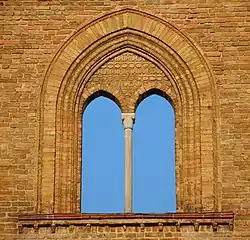 Open sky bifora in the facade of San Francesco Church
Open sky bifora in the facade of San Francesco Church Frescoes in the Church of San Francesco
Frescoes in the Church of San Francesco Cloister of Ospedale vecchio
Cloister of Ospedale vecchio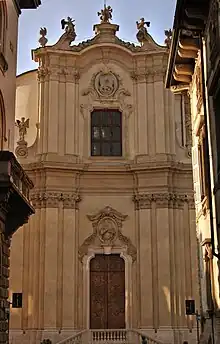 Facade of San Filippo Church
Facade of San Filippo Church Portal of Sant'Agnese Church
Portal of Sant'Agnese Church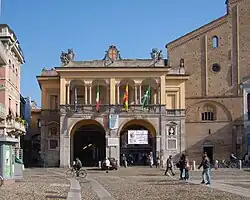 Broletto Palace viewed from Piazza della Vittoria
Broletto Palace viewed from Piazza della Vittoria Broletto square in the night
Broletto square in the night
 Vistarini Palace
Vistarini Palace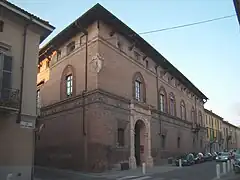 Mozzanica palace
Mozzanica palace Monument to the Italian resistance movement
Monument to the Italian resistance movement Bridge on the river Adda
Bridge on the river Adda
References
- "Dipartimento per gli Affari Interni e Territoriali".
- "Superficie di Comuni Province e Regioni italiane al 9 ottobre 2011". Italian National Institute of Statistics. Retrieved 16 March 2019.
- Population data from Istat - Italian Institute of Statistics
- Piazze d'Italia. Milan: Touring Club Italiano. 2004. ISBN 88-365-3498-8.
- "La nostra storia". www.zucchetti.it (in Italian). Retrieved 2023-06-27.
- "Dal 1978 a oggi". erbolario.com (in Italian). Retrieved 2023-06-27.
- "Gli stabilimenti produttivi in Italia". ibsa.it (in Italian). Retrieved 2023-06-27.
- Ferrari, Felice (2003). La ceramica di Lodi [Lodi ceramics] (in Italian). Azzano San Paolo: Bolis Edizioni. pp. 35–44.
- Ferrari, Felice (2003). La ceramica di Lodi [Lodi ceramics] (in Italian). Azzano San Paolo: Bolis Edizioni. pp. 45–51.
- Ferrari, Felice (2003). La ceramica di Lodi [Lodi ceramics] (in Italian). Azzano San Paolo: Bolis Edizioni. pp. 53–64.
- Gelmini, Maria Laura (1995). "L'arte ceramica lodigiana". Maioliche lodigiane del '700 [Lodi maiolica in the 18th century] (in Italian). Venice: Electa. p. 46. ISBN 88-435-5402-6.
- Ferrari, Felice (2003). La ceramica di Lodi [Lodi ceramics] (in Italian). Azzano San Paolo: Bolis Edizioni. pp. 53–64.
- Gastaldi, Francesco (27 February 2017). "Lodi, le 300 opere d'arte sepolte E il museo che non c'è da sei anni" (in Italian). Retrieved 24 January 2020.
- "Museo Civico" (in Italian). Retrieved 24 January 2020.
- "Museo Civico - Lodi" (in Italian). Retrieved 24 January 2020.
- "Lodi Sister City Committee | Lodi, CA".
Sources
- Agnelli, Giovanni (1917). Lodi ed il suo territorio nella storia, nella geografia e nell'arte. Lodi.
{{cite book}}: CS1 maint: location missing publisher (link) - Bassi, Agenore (1977). Storia di Lodi. Lodi: Edizioni Lodigraf. ISBN 88-7121-018-2.
- Mario-Giuseppe Genesi, Gli Organi Storici del Lodigiano, Piacenza, L.I.R. Editrice, 2017, pp. 720.
- Ferrari, Felice (2003). La ceramica di Lodi [Lodi ceramics] (in Italian). Azzano San Paolo: Bolis Edizioni.
- Maioliche lodigiane del '700 [Lodi maiolica in the 18th century] (in Italian). Venice: Electa. 1995. ISBN 88-435-5402-6.